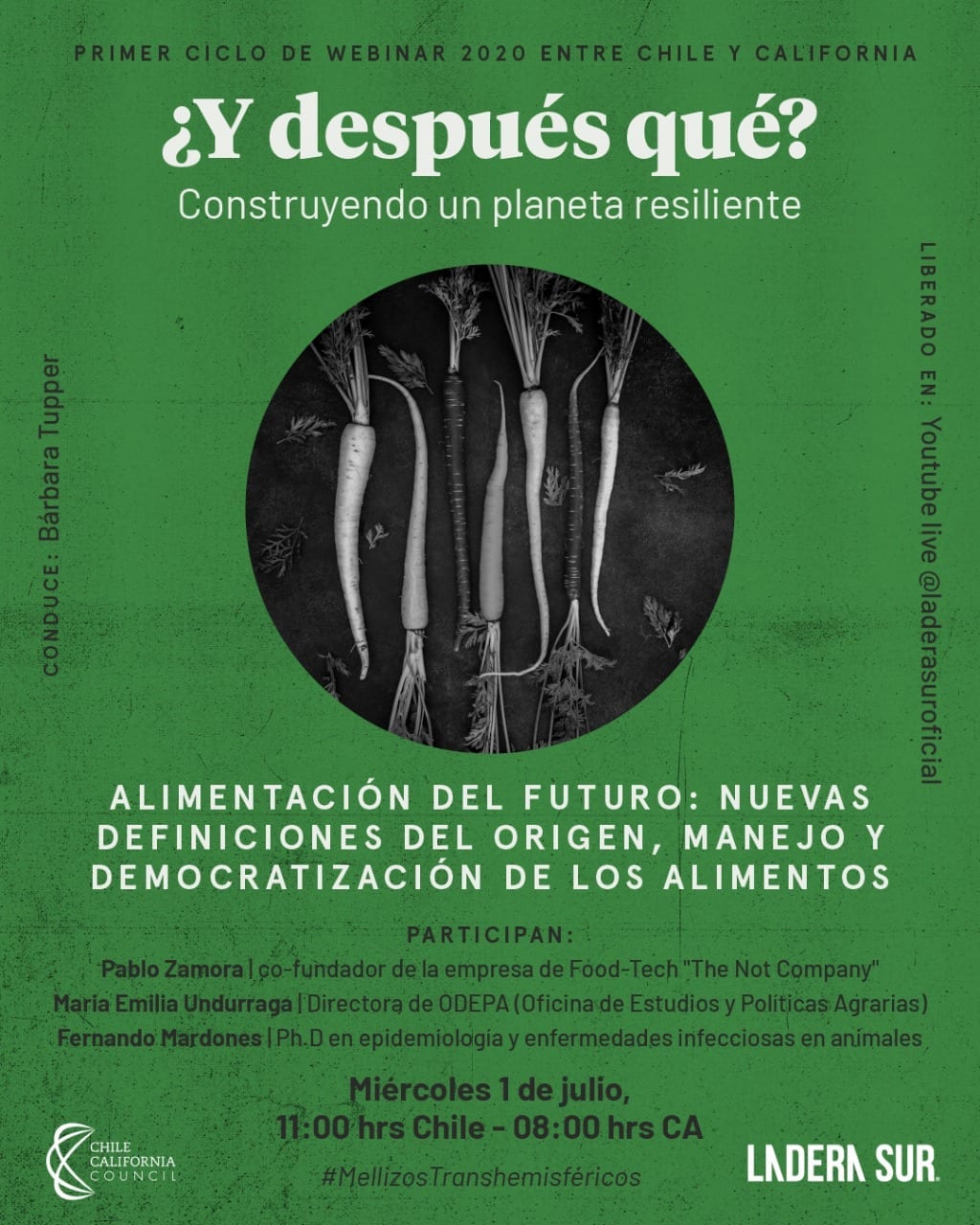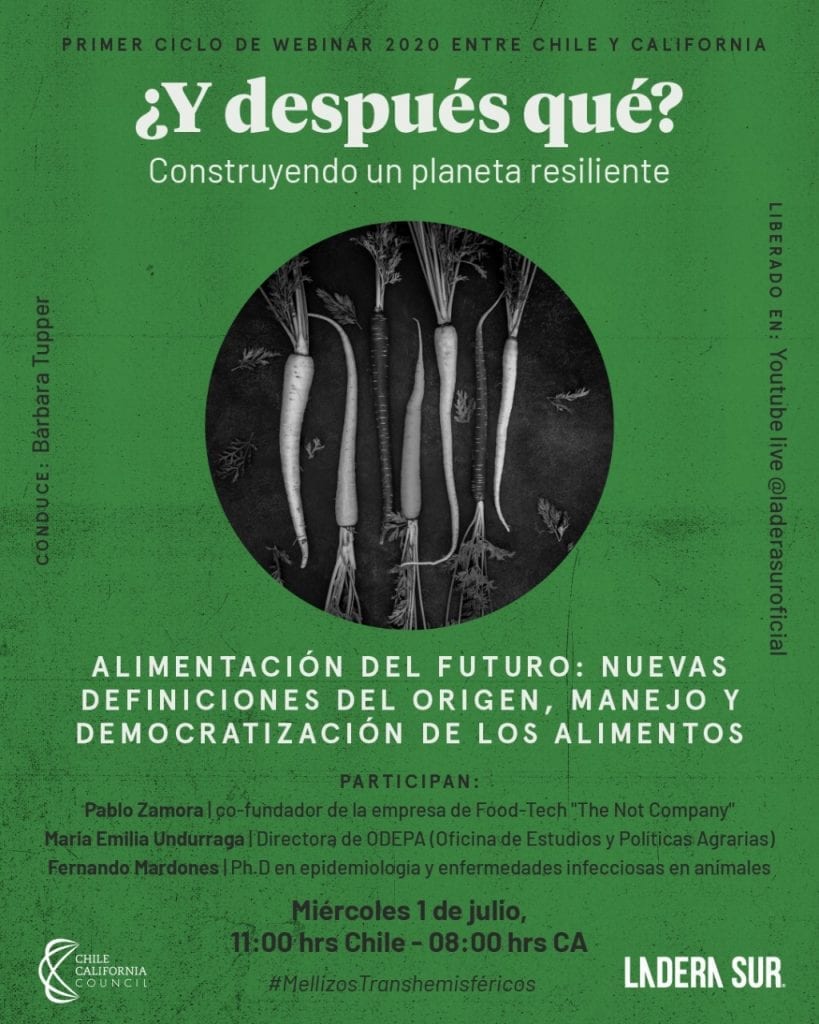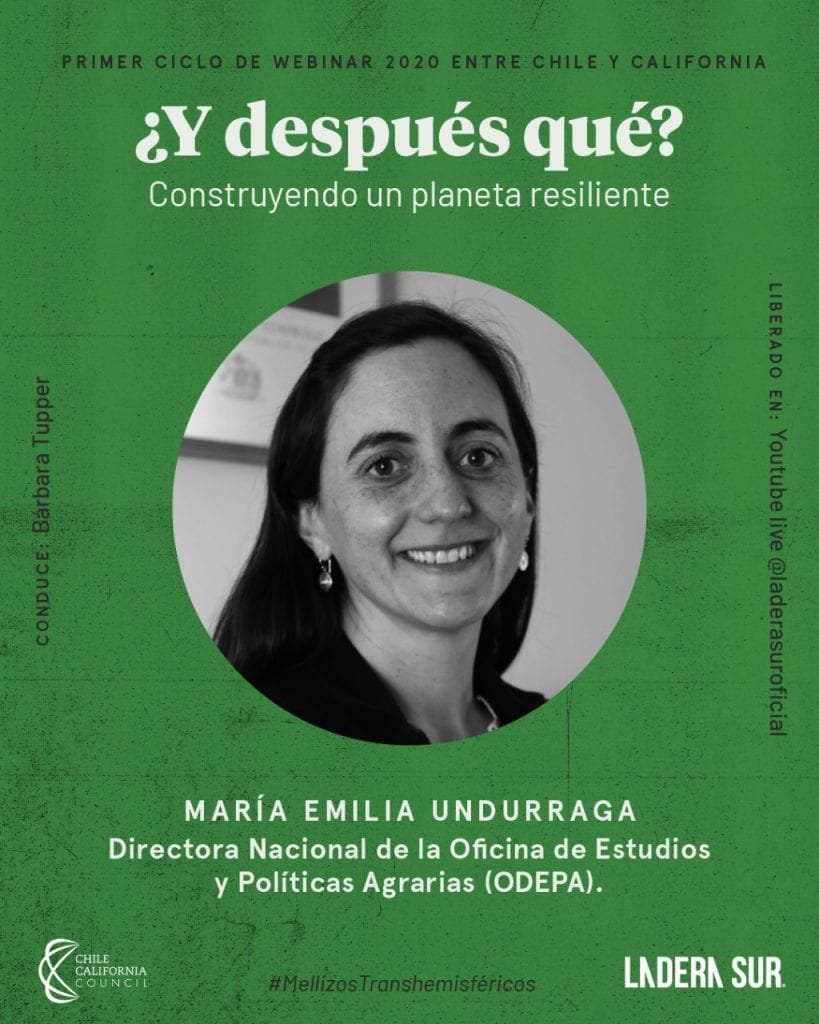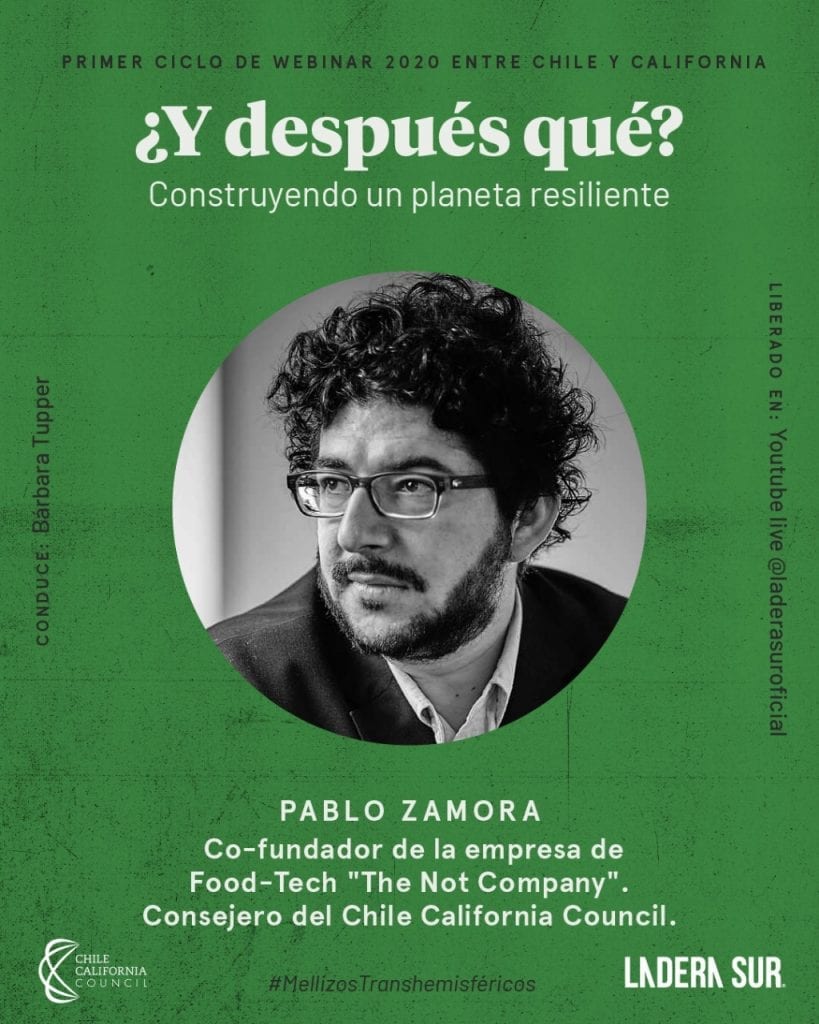¿Y después qué? Alimentación del futuro: nuevas definiciones del origen, manejo y democratización de los alimentos
Before the Covid-19 crisis, 600,000 Chileans were deprived of nutritious food and were food insecure, a figure that could reach one million people when the pandemic ends. And yet, a third of the food produced in Chile is wasted. Undoubtedly, the nation faces serious challenges regarding how to ensure that its entire population has access to food that is also sustainable, of quality and of which they are conscious. But how can food security be guaranteed to all? Can local food production be both sustainable and profitable? What role does transparency and information play in this matter? Is the livestock industry a danger to our health? These were some of the questions that were addressed in the discussion “Food of the future: new definitions of the origin, management and democratization of food,” in a new chapter of the project “And Then What? Building a Resilient Planet,” organized by Chile California Council and Ladera Sur. It also delved into the experience of California, our trans-hemispheric twin, which has made major advances in science, public policy and culture. You missed it? It is not too late! Below are a note and video that summarizes the main reflections and proposals of the guests.
Last Wednesday, July 1st, at 11:00 am, a discussion took place on “Food of the future: new definitions of the origin, management and democratization of food” on the Ladera Sur YouTube channel, the third activity of the webinar cycle “And then what? Building a resilient planet,” organized by Chile California Council and Ladera Sur.
Three prominent speakers participated in this panel, moderated by the journalist Barbara Tupper, who have devoted themselves to the study of agricultural, food, and public management processes.
Who are they? Fernando Mardones, veterinarian and doctor of epidemiology at the University of California, Davis. In addition, he is Associate Editor of Frontiers in Veterinary Sciences journal and has published more than 30 scientific articles in the area of infectious animal diseases.
Pablo Zamora, who is a co-founder of The Not Company, and the founder and Associate Director of the Center for Life Sciences Innovation at the University of California Davis in Chile. Both Pablo and Fernando are directors of the Chile California Council.
Thirdly, María Emilia Undurraga was present, an agricultural engineer who holds a Master’s degree in Sociology from the Pontifical Catholic University of Chile and is currently the national director of the Office of Agricultural Studies and Policies (ODEPA) of the Ministry of Agriculture.
Here we share some of the main topics covered by the speakers, who analyzed the challenges of the food of the future in Chile, such as the problems of ensuring food security for the entire population and the need to make transparent the ways in which production processes are carried out, and the experience that California, a “trans-hemispheric twin” of Chile, has had, which has already implemented measures to revalue the role of farmers in society.
The importance of food safety
According to the catalog of U.N. Sustainable Development Goals, today, 820 million people go to bed hungry, and of that number, about 135 million suffer from acute hunger that the U.N. says is a consequence of human conflicts, economic recessions and climate change. To overcome this serious problem, the goals say that an increase in sustainable agricultural production is necessary as is guaranteeing the food security of the population.
But what does food safety mean? That was the question answered by the first speaker, Fernando Mardones: “food security means ensuring that the population has access not only to a quantity, but also to a quality of food.”
A problem to which Chile has not been oblivious. According to Eve Crowley, representative of the Food and Agriculture Organization of the United Nations (FAO) in Chile, the economic problems that Covid-19 has produced could lead to severe food insecurity problems for 400,000 Chileans, a figure that would be added to the 600,000 who already live with this insecurity.
“In Chile, a third of the food produced is lost or wasted,” warned Maria Emilia Undurraga. In fact, according to data compiled in the FAO’s second bulletin on Food Losses and Waste in Latin America and the Caribbean, in Chile specifically, 63.3 kilograms of bread are wasted per family, equal to 16.7% of the average consumption by the national population.
Yet the highest figures for waste are not found in domestic consumption. According to figures provided by the Agricultural and Animal Husbandry Research Institute (INIA), 72% of this waste occurs in previous stages of the value chain, which include farming, handling, storage, distribution and processing.
Undurraga considers that a core consideration in food safety is to eliminate this waste, and she emphasized that one of the keys for this to happen is to monitor the entire production chain in Chile, from the moment a food is produced until it reaches the consumer. The goal must always be not to disrupt the chain to ensure that the products always truly reach families.
In Undurraga’s view: “This is a great process, a great chain. What is produced in the field must then be processed and delivered, that is why we need logistics that must also include fairs and markets. There are many people who make a living by selling these foods at a fair and reasonable price for each consumer.”
Of course, according to Undurraga, an effective reduction of food waste cannot alone guarantee food security as there are other problems: the local industry may not be able to supply all the food that Chileans may need. As recently as this past June, Chile imported more than 240 tons of legumes given the exceptional demand caused by the need to give food aid to families hit by Covid-19.
As indicated by the national director of ODEPA, maintaining a healthy diet makes us dependent on the production in other countries. She mentioned the case of rice, a food that is part of the basic food basket, 65% of which is imported by Chile. Undurraga adds that the local industry could not produce rice at a low cost because it needs a lot of water and special environmental conditions that are not present in the national territory.
On this point Pablo Zamora warned that, although the consumption trend makes it necessary to open the borders to certain foods, this must be done conscientiously as sometimes opening the agricultural market too much might be detrimental to local conditions, either ecosystems or prices. Prices, for example, may be much lower for foreign-sourced products if their producers pay low wages.
As Undurraga explained: “There is a balance between how we are incorporating our own systems with a lower carbon footprint and the cost of production. There is no doubt that we must promote local industry, but the challenge is how we are doing it so that we can also supply others, as is the case with apples that we produce for countries that cannot produce them.”
However, the director of ODEMA asserts that for this process to be effective, good practices must permeate all segments and not be elitist: “This connects it to democratization so that we can all produce food sustainably and be aware of what we can produce to waste less.”
The rise of intensive livestock farming and the importance of food safety as a pillar of food security
The consumption of meat is a trend that is on the rise. In fact, according to the FAO estimates for this decade, world livestock production will grow by 20% compared to the previous one. And it is projected that developing countries will begin to consume the most animal protein.
According to Mardones, some countries would “believe” that the amount of animal protein per capita must be increase, benchmarked to the numbers for other more developed nations. This conception, which he calls a “vice,” causes an increase in livestock intensity, that is, a productive approach aimed at maximizing production while minimizing costs. This could bring about serious health problems, especially related to food safety.
But what is food safety and why is it important? According to the Chilean Institute of Public Health (ISP), the safety of a food is the guarantee that it will not cause harm to the consumer provided it is prepared or ingested according to the intended use. Unfortunately, this is not the condition of the food consumed by a large part of the world’s population. According to FAO data, almost 600 million people on the planet get sick from having consumed food that has been contaminated by microorganisms, parasites or chemicals, and another 420,000 die from this cause.
According to Mardones, the safety of meat is affected when it comes from intensively raised livestock, but we are not necessarily talking about a farm with thousands of confined animals. The mere proximity between one animal and another or between animals and plants also represents a danger, especially for the emergence of new diseases.
Mardones commented that “There are quite recent examples: 3 out of 4 diseases come from animals. A new strain of influenza was recently reported from pig herds in China. So, once again, we are creating places that are in fact breeding grounds for viruses and pathogens that can replicate and constitute bombs for humanity.” He added that the stress that intensive livestock-raising generates in animals predisposes them to illnesses.
But how does this relate to human health? Mardones added that due to the greater presence of diseases produced by intensive animal husbandry, producers are forced to use antibiotics and chemicals, which could create antimicrobial resistance, that is, bacteria become resistant to antibiotics, which further complicates fighting them.
Another health problem linked to animal husbandry is the illegal trade of species on the black market. Mardones commented that “in other countries, as is the case of some in Africa and Asia, there is an extremely important capture of wildlife that is sold in markets and fairs. By agreeing to the capture of these animals, man is exposed to pathogens that exist in nature, but we do not know what they are. One would expect that new pathogens will also be generated there.
The challenges for manufacturing industries and new technologies
Food industries, such as forestry, agriculture, and fisheries, have a fundamental economic relevance for Chile. In fact, only during the first half of 2019 exports by those industries totaled 4.133 million dollars, according to an analysis prepared by ProChile in collaboration with the Central Bank of Chile.
However, there might be a hidden reality behind these figures: there are serious deficiencies in the food industry that, in Zamora’s eyes, make it “recalcitrant” and reluctant to change. That would be the case of large-scale farmers, who are often both owners of the arable land and of the genetics of the crops themselves.
In the words of Zamora, “Some industries, like the meat industry, are at least 50 years old and well established, earning a significant profit. One-third of the farmland is used for the production of animal protein and there are 10 times more confined animals than wild ones. These types of industries are not going to be the ones that change to an alternative system. New companies are needed and new government incentives.”
In Chile, livestock export income in 2018 exceeded $1 billion. A lucrative activity but which that same year consumed about 1,118,000 liters of water per consumer. According to Zamora, this industry has continued to function in part due to the belief that animal protein is essential because of its high nutritional value, “and that hypothesis, that there is no food source that is of the same quality, was disproved because empirical evidence shows that if you combine plants, fungi and insects, you can achieve a nutritional balance between these combinations and generate a protein that has the correct essential amino acids that allow you to regenerate muscle tissue.”
New innovations in the meat area are already being investigated internationally and are present in the agricultural world. An example of this would be vertical agriculture, which would aim to enable urban spaces, such as buildings, to grow crops. An initiative that Zamora claims is already underway in Chile.
However, he acknowledged that although these technologies can offer solutions to the problems of the agri-food industry, they are not available to all people, and that would be a big problem. Such is the case of small or subsistence farmers, who could not turn to new production trends because they have to address more basic priorities, or consumers with little buying power, who cannot opt for these foods. For this reason, Zamora stressed that a broad intensity of local production is necessary, even in countries in the region.
“This pandemic and the social outbreak have shown that there is a large population, which is the majority, who unfortunately have no options. So, on the one hand, technologies are going to show you that there are other food alternatives, but on the other hand, you have a population that needs to survive, and that is associated with food production. When we look at the food of the future, we have to consider new trends, but without forgetting this great mass of the population that needs to satisfy basic needs.”
The importance of an informed and conscious diet
The first speaker to refer to this issue was Fernando Mardones, who stated that there is currently great ignorance about the origin of the products that are being consumed, especially those that “are easily accessible,” meaning particularly to the richer social strata.
As Mardones said, “There is a food safety issue at the top of the chain, and today the numbers show that a large part of the carbon emissions or the environmental impact comes from the consumption of that part of the population. This fact is extremely important as is how it impacts the health of the planet.” He also commented that the discussion must include allowing nature to regenerate. “Although we have to produce and generate food, we also have to be able to return the things we are using to the Earth. We must repair and let nature reproduce in certain areas.”
In this sense, Mardones appreciated the fact that new protected areas have been created in the country, such as marine and terrestrial parks, although he stressed that it is not just a job of the State. “People can also do it, to have an impact on nature and recover spaces.”
According to Zamora, conscious eating means a feeding process that not only involves the product, but also its relationship with the environment, its production method, the wellbeing of farmers and the nutritional contribution it makes.
Zamora added: “Today we are more aware of what nutritional balances are required in different cultures, what the associated diets are, and how each person manages to combine food rationally based on scientific evidence, to be able to receive the corresponding calories and feed themselves in a diversified way. If we make use of that information to make decisions, we will be aware of what we eat, we will know the impact of the food that we are giving to our children and we will be more aware of the environment.” He also shared a quite particular description of human beings: as “holobionts,” which means that they are in themselves an ecosystem. When we feed ourselves, we are not only nourishing ourselves as Homo sapiens; we are also nourishing our own microbiome that lives within us.”
The relevance of transparency in production
In 2019, the Chilean Egg Producers Association (ChileHuevos) reported that egg consumption in Chile totaled 235 eggs per capita, ranking Chile fifth in Latin America. On the other hand, the egg industry in Chile would keep more than 17 million chickens locked in small cages, according to a recent study published by Sinergia Animal International that says that “The animals can hardly move and are kept on isolated farms, far from the eyes of society.” This practice leads us to question how much real information we receive on the production of a food when we buy it.
But how can production transparency be made a decisive factor in choosing the food we consume? For María Emilia Undurraga, this is part of a public role and responsibility so that consumers can have the necessary information on how a product is produced. She said that efforts are already being made at the state level because CORFO, the government development agency, is working on a project to define sustainability standards for the different Chilean industries, which would vary by sector.
This new information would in turn imply conscious consumption, something that, as Zamora mentioned, is already happening in the cocoa industry, where consumers have decreased the consumption of cocoa from the Ivory Coast “where there is precariousness, enslavement and death” and instead chosen a food without these negative externalities, such as cacao from Ecuador.
Although from Undurraga’s point of view, sustainable production is a task that not only depends on the good decisions by consumers, but also on the producers themselves. Of course, this is a task that involves many actors.
She added that “We have to understand that when we talk about sustainable food and we want to promote local production, we have to promote the development of the territories. We need connectivity, good health and education to improve diversification in production. This is not food that falls from the sky. We must consider what happens with family income, with small farmers who do not farm more than 10 hectares, 40% of whom farm less than 5 hectares, and for whom that production is the livelihood for that family.”
Food as an axis of cooperation and culture: a look at the California experience
As mentioned in the previous two discussions of this webinar cycle, looking at California is somewhat like looking at Chile. According to Zamora, one of California’s strengths, in terms of the agri-food industry, is that it would have much closer ties between the productive sector and educational institutions, a bond that would improve farming techniques.
Zamora said that “In California, they recognize that the industry does not necessarily generate the knowledge that is generated by universities, and a very interesting cooperative model has been created: for example, for each box of walnuts that producers sell, a small fraction goes to a fund to help maintain better farming practices. Agriculture there uses a lot of knowledge to optimize processes.”
This would have potential, for example, in the wine industry, which is an agricultural activity that has a large presence in both countries. Mardones also highlighted cultural aspects of agriculture in California, which is relevant in the daily lives of its citizens. He mentions that local producers sell their products at farmers’ markets and are part of the society of the towns where those markets are located.
According to Zamora, this promotes a re-evaluation of the role of farmers. Even in restaurants, the producer of fruits and vegetables is identified. This also raises consumer awareness.
The process reveals the role that these farmers have, whether they are larger or small farmers. California offers farming programs to students at universities and colleges, and Zamora assures us that they can be consumed in local restaurants: “one can go to the menu and know that the pizza has basil from such a college or the tomato produced from such a university.”
Another aspect highlighted by Mardones, and that Chile could learn from the experience of California, is land-use planning: “there they are very clear where the garlic, onion, dairy and grain sectors are; and with respect to this arrangement, we still have a long way to go to determine where are good places to grow crops are, considering the cities, geography and environmental issues,” he concluded.




